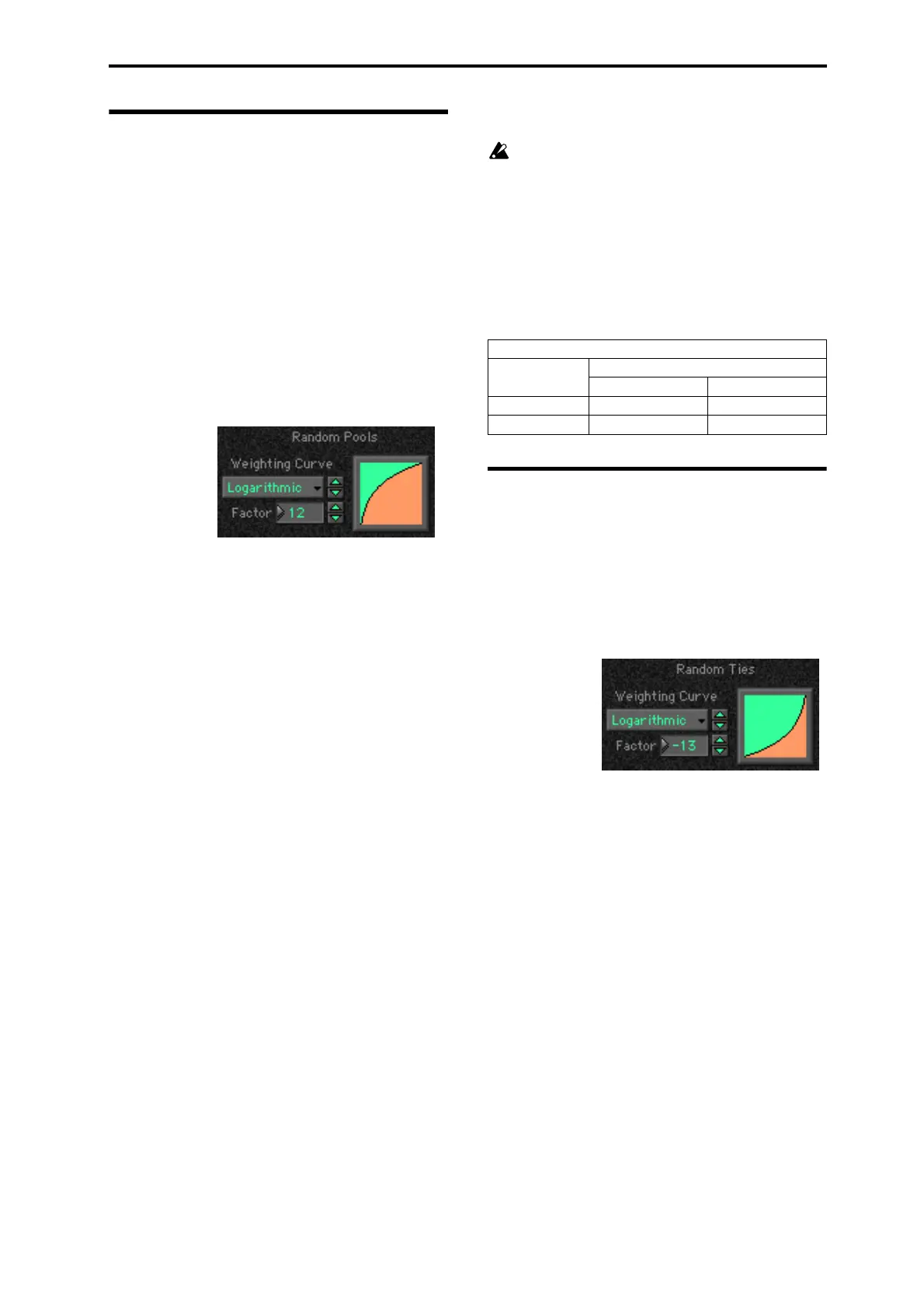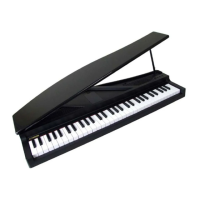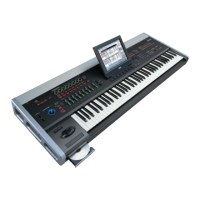Rhythm Group Random Weighting Parameters - Pools
541
Random Weighting Parameters
- Pools
The Random Weighting Parameters - Pools are made
available when at least one step (column) in the Rhythm
Pattern has multiple rhythmic values selected (constituting
a “random pool” of values).
Whenever a random pool is encountered in playing through
the pattern, a random choice is made from the values in that
step. Certain areas of the random pool can be favored by the
use of a weighting table, with various shaped curves. Using
the curves, you can influence certain choices to be made
more or less often than others, allowing very musical real-
time control of the randomness.
Whether or not a certain random sequence will repeat for a
number of times is controlled by settings in the Phase
Pattern.
Pools-Random Factor [–99…+99]
Controls the degree of slope to the Weighting Curve. 0= a
Linear Curve with any Weighting Curve. Negative values
not only invert but rotate the curve. When the value is either
+99 or –99, the choices are “locked” to the highest or lowest
values in the columns, and there are no random choices at
all. (The only exception to this is an S-shaped curve with a
value of –99. In this case, a random choice will be made
between the highest and lowest values only.) For more
information, please see the Appendices: “Random
Weighting Curves.” (☞p.584)
Pools-Weighting Curve [0…3]
4 different shapes are available, which act to favor certain
areas of the pool over others when each random choice is
made. For more information, please see “Random
Weighting Curves” on page 584.
0: Exponential
With a positive Factor (+), choices will be exponentially
weighted towards the shorter rhythms. With a negative
Factor (–), choices will be exponentially weighted towards
the longer rhythms.
1: Logarithmic
With a positive Factor (+), choices will be logarithmically
weighted towards the shorter rhythms. With a negative
Factor (–), choices will be logarithmically weighted towards
the longer rhythms.
2: Exp-S (Exponential S)
With a positive Factor (+), choices will be exponentially
weighted towards the middle rhythms, and away from the
shorter and longer rhythms. With a negative Factor (–),
choices will be exponentially weighted towards the shorter
and longer rhythms, and away from the middle rhythms.
3: Log-S (Logarithmic S)
With a positive Factor (+), choices will be logarithmically
weighted towards the middle rhythms, and away from the
shorter and longer rhythms. With a negative Factor (–),
choices will be logarithmically weighted towards the shorter
and longer rhythms, and away from the middle rhythms.
A Factor of 0 with any shaped curve yields a linear
table (straight diagonal line), and each of the values in
the pool will have an equal chance of being chosen.
Note: While exponential and logarithmic curves may seem to
have a similar shape, they have slight differences which can
affect the outcome of the random choices. For more
information, please see “Random Weighting Curves” on
page 584.
The following table summarizes the effect of the various
Weighting Curves and the Factor field on the choices from
the Rhythm Pools:
Random Weighting Parameters
- Ties
The Random Weighting Parameters - Ties are made
available when at least one step in the Rhythm Pattern
contains a Random Tie. Whenever this step is encountered
in playing through the pattern and a random choice must be
made, the likelihood of a tie occurring can be favored by the
use of a weighting table.
Ties-Random Factor [–99…+99]
Controls the degree of slope to the Weighting Curve. 0 = a
Linear Curve with any Weighting Curve. Negative values
not only invert but rotate the curve. When the value is +99,
the choices are “locked” to no ties whatsoever; when the
value is –99, the choices are “locked” to ties always (and the
effect is the same as if absolute ties were selected). For more
information, please see “Random Weighting Curves” on
page 584.
Ties-Weighting Curve [0, 1]
2 different shapes are available, which affect the likelihood
of a tie occurring when a random choice is made. For more
information, please see “Random Weighting Curves” on
page 584.
0: Exponential
With a positive Factor (+), choices will be exponentially
weighted towards rhythm values more often. With a
negative Factor (–), choices will be exponentially weighted
towards ties more often.
1: Logarithmic
With a positive Factor (+), choices will be logarithmically
weighted towards the rhythm values more often. With a
negative Factor (–), choices will be logarithmically weighted
towards the ties more often.
0: Exponential 2: Exp-S
1: Logarithmic 3: Log-S
Rhythm Pool values that receive priority:
Weighting
Curve
Factor
+ (positive) – (negative)
Exp/Log longer shorter
Exp-S/Log-S middle shorter/longer
0: Exponential 1: Logarithmic

